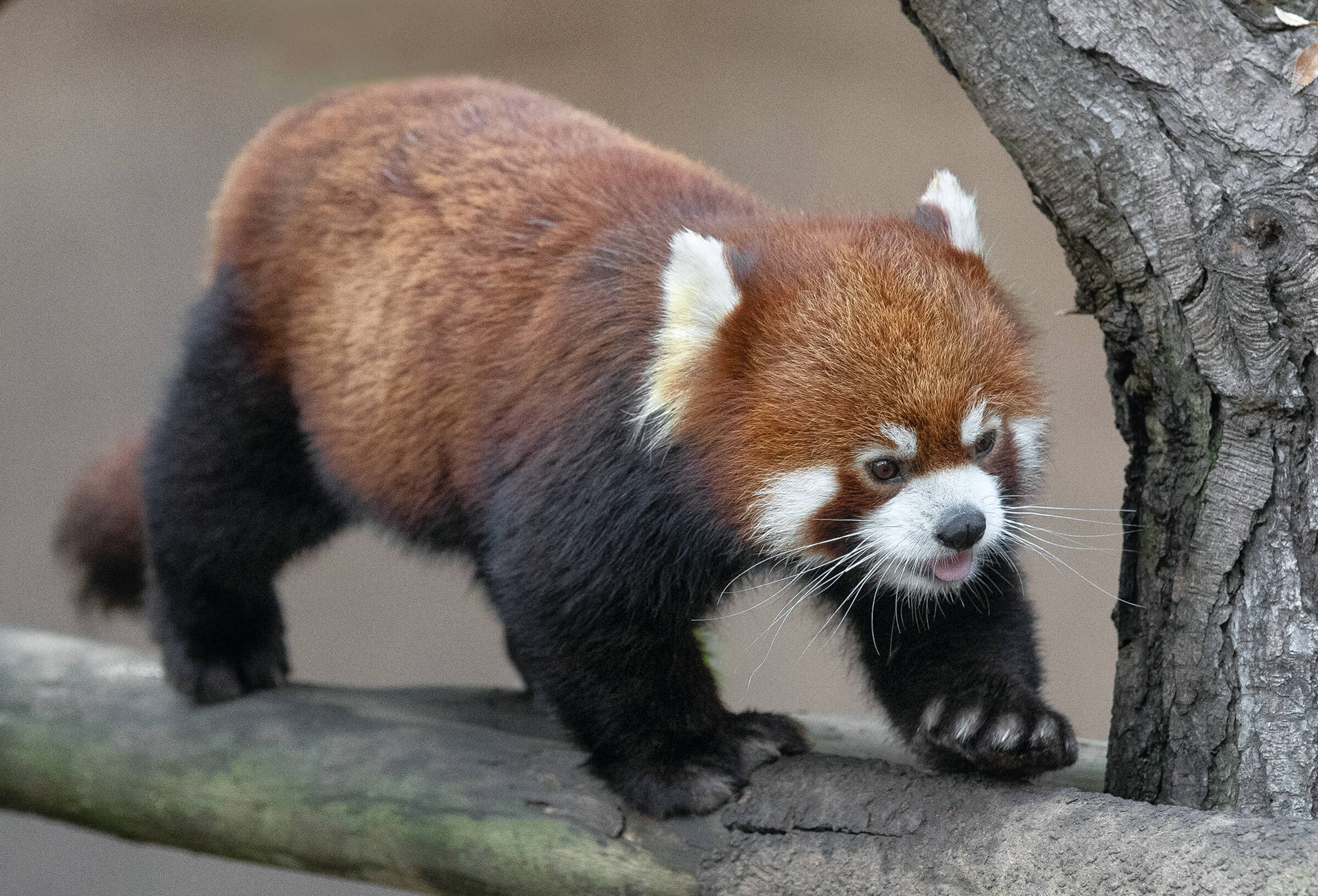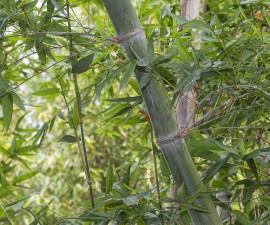BY Eston Ellis
Photography by Ken Bohn
When guests see a red panda at the San Diego Zoo, their first reaction is often “what’s that?” What they see is a fiery red-orange and reddish-brown mammal about the size of a large house cat, with a round face, keen eyes, distinctive white and brown markings, a long, fluffy tail, and a fondness for climbing trees. But it’s not a cat. It’s not a fox or a raccoon. And it’s not a bear.
Despite the name, red pandas are only distantly related to giant pandas. In fact, the western red panda Ailurus fulgens fulgens was first described by French zoologist Frédéric Cuvier in 1825, 48 years before the giant panda became known to Western science. “Red pandas are the original panda,” said Nicki Boyd, associate curator of behavioral husbandry at the San Diego Zoo, and the Zoo’s red panda Institutional Representative. The western red panda’s taxon name comes from the Greek words for cat, ailouros, and fire-colored, fulgens. A second red panda subspecies—the slightly larger and more brightly colored Styan’s red panda A. f. refulgens (styani)—was discovered in 1897. The word “panda” is believed to have been derived from a Nepalese phrase, nigalya ponya, said to mean “bamboo eater” or “bamboo footed.”
Both red pandas and giant pandas can be found in China—although red pandas are also found in mountain forests of Nepal, India, Bhutan, and Myanmar. Both spend most of each day eating bamboo, although giant pandas eat the stalk or culm along with the leaves, and red pandas only eat the leaves. Like the giant panda, red pandas have a wrist bone called a “false thumb” that allows them to grasp a stalk of bamboo with their paw. But the similarities mostly end there.
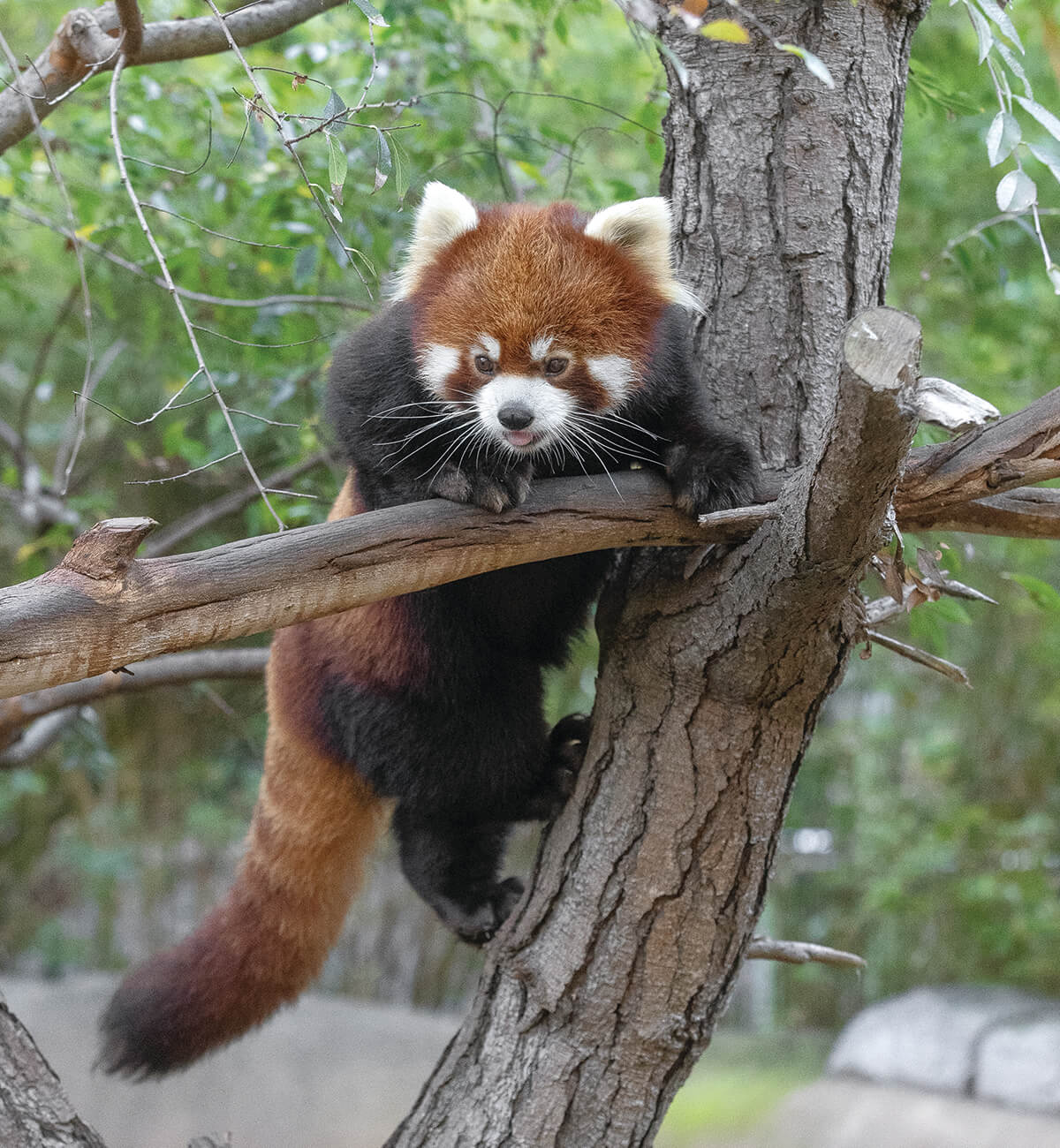
BRANCHING OUT
In the Zoo’s red panda exhibit, there are trees to climb and branches to traverse—and the red pandas encounter food and treats in continually changing locations, to encourage them to forage and explore.
Red pandas are members of their own unique family: Ailuridae. They are considered crepuscular (active at dawn and dusk) or nocturnal, but they often forage or bask in filtered sun on tree limbs during the day. Sometimes called a “vegetarian carnivore,” a red panda may occasionally eat eggs or small animals like birds, but they prefer eating bamboo, which makes up more than 80 percent of their diet. Some red pandas also eat fruit, mushrooms, and bark, and red pandas at the Zoo eat leaf-eater biscuits in addition to fresh bamboo leaves.
Red pandas are mostly solitary animals, except during mating season or when mothers are raising cubs. During mating season, red pandas communicate through a unique series of vocalizations, including bleats, squeals, snorts, and sighs; along with scent marking and head bobbing. At other times, red pandas may make a “huff” sound that means “don’t get too close,” or a snort that means “I just want you to know I’m right here,” said Karen Scott, red panda keeper.
They have claws designed for climbing trees and self defense—and they are excellent climbers, as well as being adept swimmers. While they spend much of their time up in trees, they also spend a lot of time on the ground, eating bamboo. When they climb down from a tree, they go down the trunk headfirst—an unusual skill for a mammal.
Like raccoons, red pandas are known for washing their faces with their paws, and dipping their paws into water to drink. At the Zoo, our red pandas enjoy drinking out of misters, too. While red pandas are not cats, you might think they were when they’re sleeping. “They curl up just like a cat, and use their fluffy tail as a blanket,” Karen said.
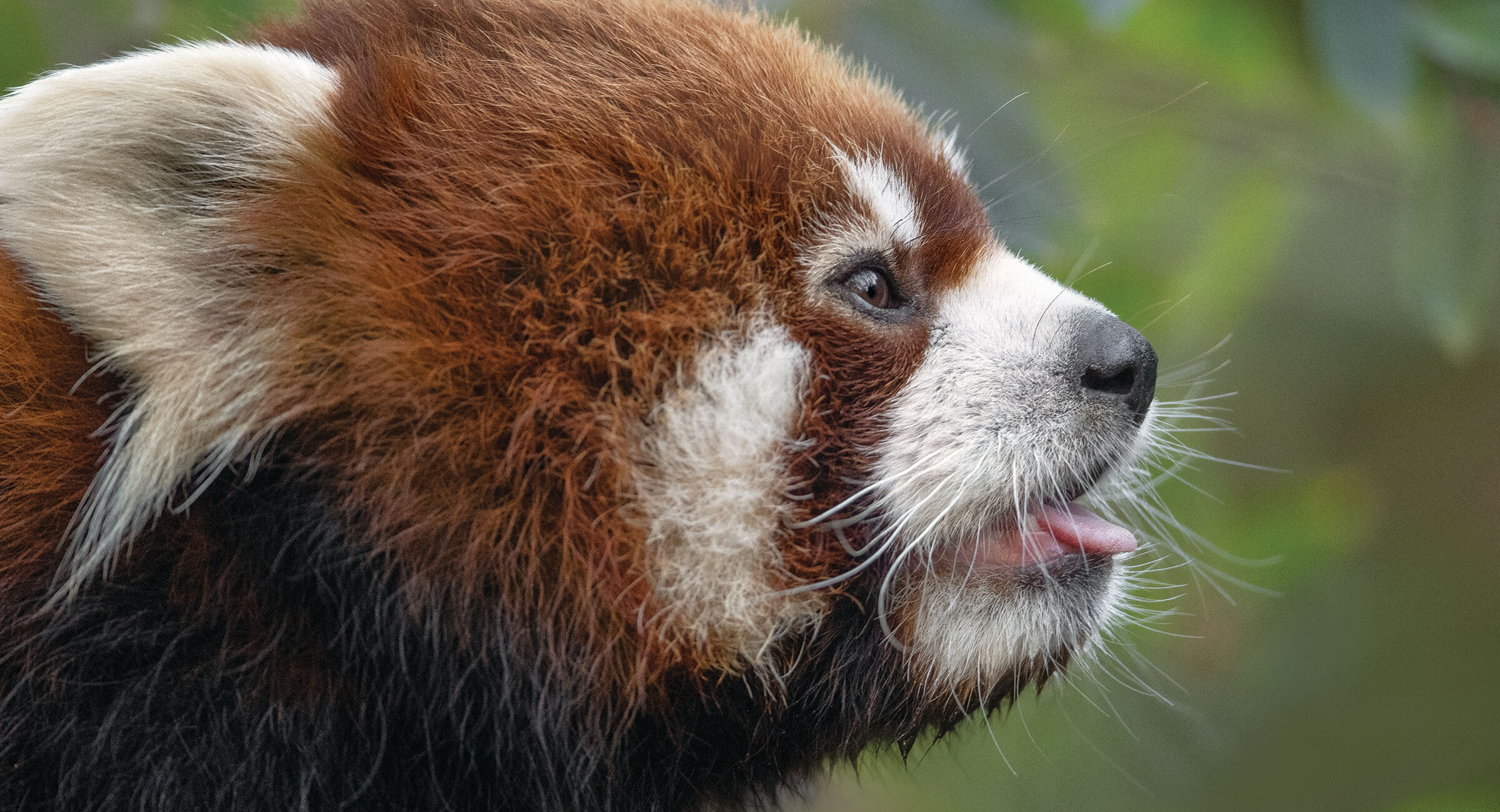
Helping Red Pandas
Red pandas live in high elevations in the Himalayas, in cool, dense forests with abundant bamboo. They are categorized as Endangered on the International Union for Conservation of Nature (IUCN) Red List of Threatened Species.
No one knows exactly how many red pandas are left in their native habitats. In 1999, it was estimated that fewer than 2,500 still existed; however, most current estimates put their numbers closer to 10,000. They face many threats as people encroach on their home forests: poaching for their fur or for the illegal pet trade; predation by feral dogs; destruction of their habitat by free-roaming cattle; and deforestation caused by forest fires, agriculture, and harvesting of wood for building, cooking, and heating.
San Diego Zoo Global supports the nonprofit Red Panda Network in its conservation efforts. Nicki has worked with Red Panda Network since its founding in 2006, and she currently serves as a board member. “The conservation work is focused mostly in Nepal—and this is boots-on-the-ground conservation,” she explained. “We have a group of people there who do community-based conservation, and we’re working hand-in-hand with local communities to save a precious resource.”
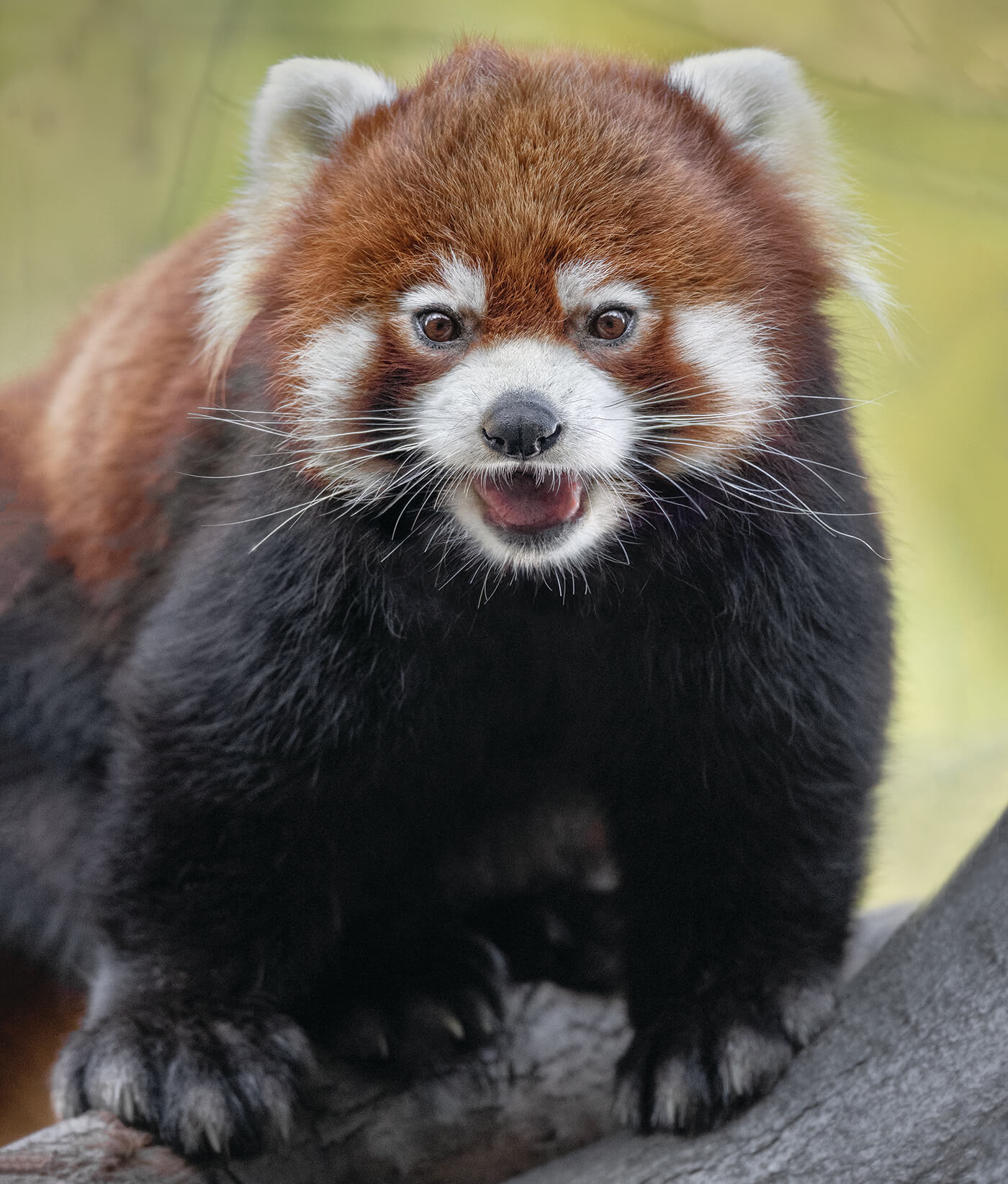
SEEING RED
The colors of a red panda—ranging from fiery orange to warm cinnamon brown and white—inspired their Chinese name: “hun-ho,” which means fire fox.
These efforts include helping to establish protected forests and wildlife corridors, and to conserve existing populations of red pandas in the Himalayas. In areas where the use of wood for heating and cooking has become a major threat to the forests, Red Panda Network is working with community members to replace wood-burning stoves with new, more efficient stoves that burn renewable bio briquettes—and they are training locals to produce their own bio briquettes. “This is a high-altitude area that is very cold, and before bio briquettes, people would spend hours going out and collecting wood,” Nicki explained. “Now they have more time, and they can use it to make crafts to sell, creating a sustainable livelihood.”
Ecotourism and home stays, in which visiting hikers can stay in the homes of local families, is providing additional income for communities. “We’ve started to build a community conservation center, which will allow researchers, tourists, local communities, and school groups to be educated about red pandas as they hike into the Himalayas,” Nicki said.
Red Panda Network trains community members to become “forest guardians,” with anti-poaching patrols to actively protect red pandas and their habitats. The network has also worked with communities to plant thousands of native trees to replace lost vegetation, restore degraded water sources, and neuter feral dogs. In addition, the Red Panda Network helps locals adopt better livestock husbandry practices, reducing the number of free-roaming cattle; and teaches sustainable organic farming methods, to help prevent further destruction of habitat.

LOOK UP
Red pandas spend a lot of time in trees. They are sure-footed climbers, with sharp claws and a long tail for balancing on even the shakiest branch—and they climb down the trunk headfirst.
Red Panda Network currently monitors red pandas in the Himalayas and participates in a Population and Habitat Viability Assessment (PHVA). “We have used trail cameras to monitor red pandas, but they live in wet, rainy forests, and they are so hard to track,” Nicki said. “However, red pandas use a shared latrine or poop spot, and through environmental DNA (eDNA) assessment of samples from these sites, we will be able to count and identify individuals that are using those latrines.”
The conservation efforts aimed at saving red pandas are actually having a much broader effect on the forests of the Himalayas, Nicki said. “The Himalayas provide one fifth of the world’s population with clean air and clean water. Along with providing a home for red pandas, the Himalayas are a habitat for many birds, hundreds of plants, and other remarkable species, like clouded leopards. So, saving this habitat has so much more impact than saving just red pandas.”
In addition to its support of conservation work in the Himalayas, the San Diego Zoo participates in the red panda Species Survival Plan (SSP) program, administered through the Association of Zoos and Aquariums. The goal of the SSP is to maintain a healthy, genetically diverse assurance population of this threatened species in managed care. As part of the plan, the Zoo works with the SSP coordinators on potential moves or exchanges of our red pandas in the Zoo’s Asian Passage habitat.
“Our red panda exhibit is currently an educational exhibit, rather than one with a focus on breeding,” Nicki said. “There is a lot going on near there, and there are a lot of people around all the time. For an exhibit to be right for breeding, you need to provide a comfort level for mom, which usually means more private space.” It’s also an area where red pandas can be cared for off exhibit when appropriate. For example, the Zoo’s 16-year-old, non-breeding female—named Hun-E—is in her golden years. Even though she has arthritis, she enjoys spending most of the day sunbathing in an off-exhibit area, with a climbing ramp to help her reach her favorite lounging spot on a tree branch.
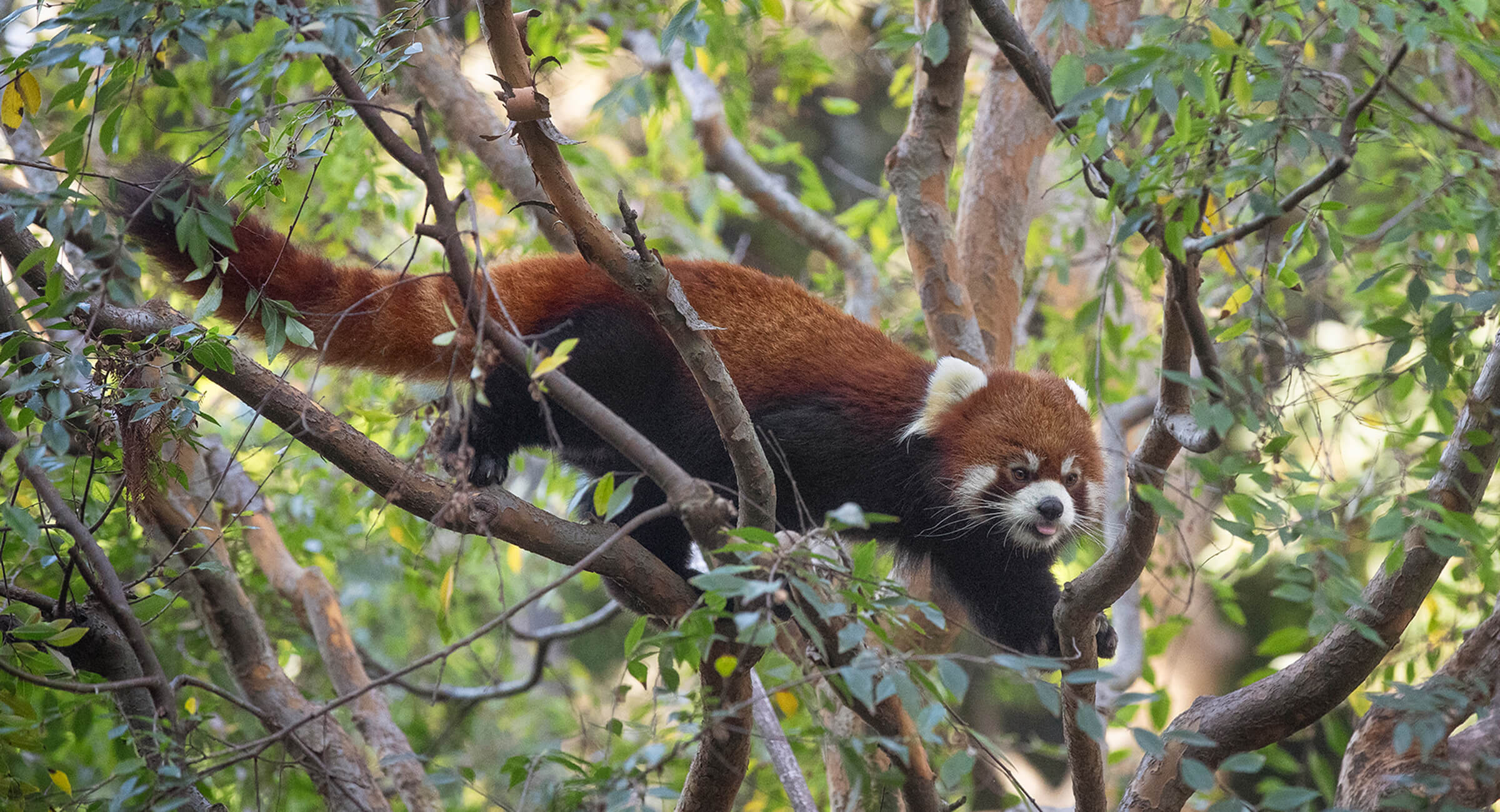
Daily Delights
The red panda keepers plan out a variety of ways to make the animals’ habitat dynamic, so that guests can experience the behaviors of this unusual species. The red pandas have trees to climb and branches to negotiate—a species specialty. Recently, the trees were trimmed to give guests a better view as the red pandas traverse the branches or lounge up high. However, the pandas still have plenty of leafy places to hide for a little privacy or a nap, Karen said.
The red pandas encounter food and treats on the ground and in the trees, in a variety of continually changing locations, to encourage them to forage and explore. They are also provided with a wide array of enrichment items, including gourds bearing different scents, and food puzzles to keep daily experiences interesting and unpredictable, as they would be in a wild habitat.
“Our red pandas are also crate trained and target trained,” Karen said. “They will come to a target stick when they are prompted—anywhere in the exhibit—and then get a biscuit treat.”
“Red pandas are unique, in everything they do,” Karen said. “You can watch a red panda start walking, and then all of a sudden he’ll run like he’s chasing something. They are playful and curious, and a great example of the species diversity in Asian rain forests. And everyone loves seeing them!” How could you not, with an adorable face like that?

